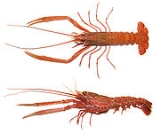
Metanephrops
Encyclopedia
Metanephrops is a genus of lobster
s, commonly known as scampi
. Important species for fishery
include Metanephrops australiensis
(Australian scampi) and Metanephrops challengeri
(New Zealand scampi). It differs from other lobsters such as Homarus
and Nephrops norvegicus in that its two main claw
s are of equal size, rather than being differentiated into a crusher and a pincher. There are 18 extant species recognised in the genus:
A further three species are known from fossils:
Lobster
Clawed lobsters comprise a family of large marine crustaceans. Highly prized as seafood, lobsters are economically important, and are often one of the most profitable commodities in coastal areas they populate.Though several groups of crustaceans are known as lobsters, the clawed lobsters are most...
s, commonly known as scampi
Scampi
Scampi is the term for a particular type of lobster, deriving originally from the Greek word κάμπη 'kampē' meaning a 'bending' or 'winding'. The name is sometimes used loosely to describe a style of preparation typically for seafood, and as a culinary name for some species of crustacean...
. Important species for fishery
Fishery
Generally, a fishery is an entity engaged in raising or harvesting fish which is determined by some authority to be a fishery. According to the FAO, a fishery is typically defined in terms of the "people involved, species or type of fish, area of water or seabed, method of fishing, class of boats,...
include Metanephrops australiensis
Australian scampi
Metanephrops australiensis, commonly known as Australian scampi, is a species of lobster. It is found off the north-west coast of Western Australia, ranging from the city of Eucla to Indonesia. It is prolific near Port Hedland....
(Australian scampi) and Metanephrops challengeri
Metanephrops challengeri
Metanephrops challengeri is a species of lobster from New Zealand. It was first collected by the Challenger expedition of 1872–1876, but only described as separate from related species by Heinrich Balss in 1914...
(New Zealand scampi). It differs from other lobsters such as Homarus
Homarus
Homarus is a genus of lobsters, which include the common and commercially significant species Homarus americanus and Homarus gammarus . The Cape lobster, which was formerly in this genus as H...
and Nephrops norvegicus in that its two main claw
Claw
A claw is a curved, pointed appendage, found at the end of a toe or finger in most mammals, birds, and some reptiles. However, the word "claw" is also often used in reference to an invertebrate. Somewhat similar fine hooked structures are found in arthropods such as beetles and spiders, at the end...
s are of equal size, rather than being differentiated into a crusher and a pincher. There are 18 extant species recognised in the genus:
- Metanephrops andamanicus (Wood-Mason, 1891)
- Metanephrops arafurensis (De Man, 1905)
- Metanephrops armatus Chan & Yu, 1991
- Metanephrops australiensis (Bruce, 1966)
- Metanephrops binghamiMetanephrops binghamiMetanephrops binghami, the Caribbean lobster or Caribbean lobsterette, is a lobster which inhabits the western Atlantic region: from the Bahamas and southern Florida to French Guiana, including the Gulf of Mexico and the Caribbean Sea....
(Boone, 1927) - Metanephrops boschmai (Holthuis, 1964)
- Metanephrops challengeriMetanephrops challengeriMetanephrops challengeri is a species of lobster from New Zealand. It was first collected by the Challenger expedition of 1872–1876, but only described as separate from related species by Heinrich Balss in 1914...
(Balss, 1914) - Metanephrops formosanus Chan & Yu, 1987
- Metanephrops japonicusMetanephrops japonicusMetanephrops japonicus is a species of lobster found in Japanese waters, and a gourmet food in Japanese cuisine. It occurs from Chōshi, Chiba Prefecture to the east coast of Kyushu, where it lives at depths of . Adults grow to a total length of , and a carapace length of ....
(Tapparone-Canefri, 1873) - Metanephrops mozambicus Macpherson, 1990
- Metanephrops neptunus (Bruce, 1965)
- Metanephrops rubellus (Moreira, 1903)
- Metanephrops sagamiensis (Parisi, 1917)
- Metanephrops sibogae (De Man, 1916)
- Metanephrops sinensis (Bruce, 1966)
- Metanephrops taiwanicus (Hu, 1983)
- Metanephrops thomsoni (Bate, 1888)
- Metanephrops velutinus Chan & Yu, 1991
A further three species are known from fossils:
- Metanephrops jenkinsi Feldmann, 1989 – Late CretaceousLate CretaceousThe Late Cretaceous is the younger of two epochs into which the Cretaceous period is divided in the geologic timescale. Rock strata from this epoch form the Upper Cretaceous series...
- Metanephrops motunauensis Jenkins, 1972 – PliocenePlioceneThe Pliocene Epoch is the period in the geologic timescale that extends from 5.332 million to 2.588 million years before present. It is the second and youngest epoch of the Neogene Period in the Cenozoic Era. The Pliocene follows the Miocene Epoch and is followed by the Pleistocene Epoch...
- Metanephrops rossensis Feldmann et al., 1993 – Late Cretaceous

